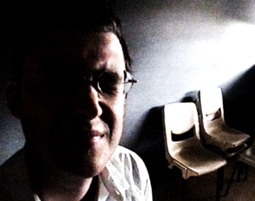..."New"/new ways of thinking/hearing/seeing the music-video...
So here it is…the music video. I have never been a fan of the post modern, the expressions and all its implications that is, particularly in regards to any “thing” that correlates to the audiovisual moving image. When I read for instance Peter Wollen [1], I finish feeling like he’s an old fart looking back at his youth, grumbling. Maybe he isn’t…haven’t met the guy…anyways, watching late, late night music television on Saturday the 20 May 2006 (Rage, music television on Australian ABC), I suddenly realise the man is (was?) right after all…(Or was he: snigger?!?). The videos did what Kaplan [2] said they would, get you hooked so that you keep on watching, and listening as Vivian Sobchack [3] and Michael Goodwin [4] points out. There were good videos and bad videos, visually striking ones and band performance ones, good ideas and dull ones…so far, so good, all-quiet-at-the so forth and so on. When I then started analysing the flow of images, seeing the levels of metaphor, subtext and lines to future past, it struck me. “Man have I seen these images before”. Kubrick, Carroll, Beatles on Ed Sullivan show, Sixties, fairlycheap-and-easytouse-dv-equipment, Nazi uniforms, Triumph of the Will, and on and on. Take your pick from the cauldron of culture and it was probably there. Thus, he was right old Pete. It is a collage, a cinematically and televisually arresting one though, but nonetheless a collection of already expressed and perceived images/signs/signifiers/etc., creating a thick mish-mesh. I have never really had a problem with that part of Wollen's argument, but when he says this is a problemtic point and I think to myself: “Wollis, you are soo old” But tonight I realised he was right in that regard too. Watching one of these bands from that first subculture-that-is-a pop-culture/that-is-a-sub-culture youth-cultures (Press Corpse - ANTI-FLAG SBME and Write Sins Not Tragedies - PANIC! AT THE DISCO Warner) the new goth-punks the emos, scream cores whatever you call it, I asked myself: "Do these kids know what these images can mean. Have they seen Riefenstahl? Do they know socio-cultural and historic signifiers her imagery carries with them?" YES you say? Well, if so stop reading……………………
if not, as I did (thinking and writing that is), it makes you think right? If they don’t…what does that mean? Are we in trouble then, will this create chaos and further violence…Because the connections are quite obvious. But then comes the kicker, is that because I’m looking at it with post-modern glasses? Thus, confusion ensues.
But then I realize that it has all been a bad-day dream, because, after all, and so forth, my field of interest is of course not this: but rather, the aesthetics, the affectiveness , the phenomenon, of the video, in short: the cinesthetic montage of the music video…more to follow…
[1] Wollen, P. (1986). Ways of thinking about music video (and post-modernism). Critical Quarterly, 28(1/2), 167-170.
[2] Kaplan, E. A. (1987). Rocking Around the Clock: Television, Post-Modernism and Consumer Culture. New York: Methuen.
[3] Sobchack, V. (1992). The Address of the Eye: A phenomenology of film experience. Princeton, NJ: Princeton University Press.
[4] Goodwin, M. (1992). Dancing in the Distraction Factory: Music television and popular culture. Minneapolis: University of Minnesota Press.
if not, as I did (thinking and writing that is), it makes you think right? If they don’t…what does that mean? Are we in trouble then, will this create chaos and further violence…Because the connections are quite obvious. But then comes the kicker, is that because I’m looking at it with post-modern glasses? Thus, confusion ensues.
But then I realize that it has all been a bad-day dream, because, after all, and so forth, my field of interest is of course not this: but rather, the aesthetics, the affectiveness , the phenomenon, of the video, in short: the cinesthetic montage of the music video…more to follow…
[1] Wollen, P. (1986). Ways of thinking about music video (and post-modernism). Critical Quarterly, 28(1/2), 167-170.
[2] Kaplan, E. A. (1987). Rocking Around the Clock: Television, Post-Modernism and Consumer Culture. New York: Methuen.
[3] Sobchack, V. (1992). The Address of the Eye: A phenomenology of film experience. Princeton, NJ: Princeton University Press.
[4] Goodwin, M. (1992). Dancing in the Distraction Factory: Music television and popular culture. Minneapolis: University of Minnesota Press.


0 Comments:
Post a Comment
<< Home